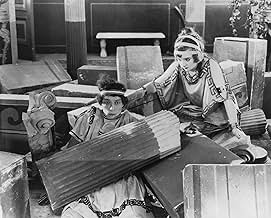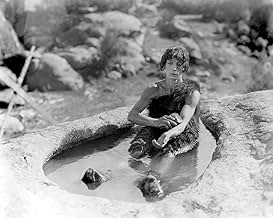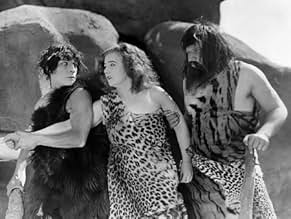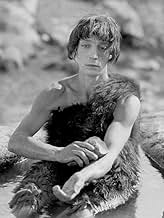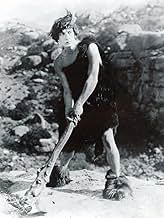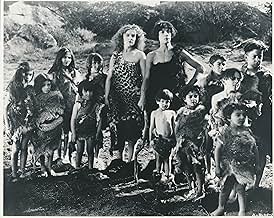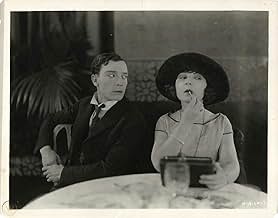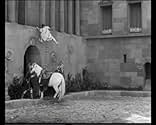IMDb RATING
7.0/10
5.6K
YOUR RATING
The misadventures of Buster in three separate historical periods.The misadventures of Buster in three separate historical periods.The misadventures of Buster in three separate historical periods.
- Awards
- 1 nomination total
Kewpie Morgan
- The Emperor
- (as Horace Morgan)
- …
Lionel Belmore
- Undetermined Role
- (unconfirmed)
- (uncredited)
Bernard Berger
- Roman-age child
- (uncredited)
Basil Bookasta
- Stone Age Child
- (uncredited)
George Bookasta
- Stone Age Child
- (uncredited)
George Davis
- Roman Guard Knocked Down
- (uncredited)
Louise Emmons
- Old Fortune Teller
- (uncredited)
F.F. Guenste
- Butler
- (uncredited)
Blanche Payson
- The Amazon
- (uncredited)
Featured reviews
"The Three Ages," Buster Keaton's first feature-length film after a number of comedy shorts, is his parody of Griffith's "Intolerance." Keaton tells three parallel stories about the perils of romance, one set in the Stone Age, one during the Roman Empire, and one during the 20th century.
In the context of Keaton, I don't see "The Three Ages" given a lot of mention. This is a shame, since while it's not Keaton's finest work, it ranks with his funniest. In one scene, Buster falls into a pit with a lion. Afraid of getting eaten, he pampers the lion and gives it a manicure. What follows is one of the funniest visual gags I've ever seen.
In the context of Keaton, I don't see "The Three Ages" given a lot of mention. This is a shame, since while it's not Keaton's finest work, it ranks with his funniest. In one scene, Buster falls into a pit with a lion. Afraid of getting eaten, he pampers the lion and gives it a manicure. What follows is one of the funniest visual gags I've ever seen.
I'd have to rate this as slightly above-average Keaton fare. It shows Buster trying to romance the girl away from Wallace Beery, and what would have transpired if the story had taken place in (1) the Stone Age; (2) The Roman Age, and (3) The Modern Age.
I liked them in that order, too, with more laughs with the older periods of time, although I laughed at the hardest at a couple of segments in the Roman Age. My favorite was the chariot race held in the sand. That had a number of clever things in the segment. The brief bit with the lion was funny, too, sort of a parody of the Biblical story of Daniel in the lion's den.
They were smart only going five minutes or so with each age and then going back with the story each time. Each "age" had four or five segments in total.
Nothing hilarious but definitely worth your time if you are checking out silent film comedies
I liked them in that order, too, with more laughs with the older periods of time, although I laughed at the hardest at a couple of segments in the Roman Age. My favorite was the chariot race held in the sand. That had a number of clever things in the segment. The brief bit with the lion was funny, too, sort of a parody of the Biblical story of Daniel in the lion's den.
They were smart only going five minutes or so with each age and then going back with the story each time. Each "age" had four or five segments in total.
Nothing hilarious but definitely worth your time if you are checking out silent film comedies
This is a pleasant and funny combination of slapstick and satire, period humor and romantic comedy. It does not have quite the number of sustained chase/stunt sequences as in most of Keaton's features, but instead there are a lot of fine subtle gags of all different kinds.
In each of the "Three Ages", Buster and Wallace Beery vie for the affections of the same woman, with amusing and unpredictable results. The simple romantic triangle theme sets up a lot of good material, on the one hand lending itself to a lot of gags about the unchanging nature of romantic courtship, and on the other hand being used for a lot of deliberate anachronisms that are often extremely funny. Beery makes a nice foil for Keaton, and the girl's parents also have some good moments.
This one usually gets lost in the crowd among so many brilliant Keaton masterpieces, but it works very well and is definitely worth seeing for any fan of silent comedy.
In each of the "Three Ages", Buster and Wallace Beery vie for the affections of the same woman, with amusing and unpredictable results. The simple romantic triangle theme sets up a lot of good material, on the one hand lending itself to a lot of gags about the unchanging nature of romantic courtship, and on the other hand being used for a lot of deliberate anachronisms that are often extremely funny. Beery makes a nice foil for Keaton, and the girl's parents also have some good moments.
This one usually gets lost in the crowd among so many brilliant Keaton masterpieces, but it works very well and is definitely worth seeing for any fan of silent comedy.
The more time I spend with old films, the more of a giant I see Keaton to be. I'm beginning to think that we all need to see a lot of him, which is why I wandered into this. It seems to have been made only because they had access to a Roman set.
The setup is that a courtship story is presented in three eras: a cave-man setup, a Roman context and a modern one. All are based on film notions of those eras of course. Unlike most movie humor of the time, the joke here isn't in embellishing the story with humorous decoration. Its in the difference among the stories.
Its a clever piece of what I call folding, and you will see at least one scene here that I swear is quoted in "Rashomon."
So there's the idea of the thing, which is worthwhile, but now I've explained it, you hardly have to see it. The jokes are trite. But there is one scene that I recall over and over. I think Keaton did it elsewhere and several others too, but here it is the best.
He's driving a car, a rickety one to his girl's house. (This is in the modern setting, obviously.) He hits a bump and the car falls to pieces. And I just don't mean the wheels fall off, the car quite literally disassembles into the parts that went into the factory and there he sits among hundreds of items. I have no idea how he did this. The car really is moving as a car, and then in an instant it is in pieces.
Wonderful.
Ted's Evaluation -- 3 of 3: Worth watching.
The setup is that a courtship story is presented in three eras: a cave-man setup, a Roman context and a modern one. All are based on film notions of those eras of course. Unlike most movie humor of the time, the joke here isn't in embellishing the story with humorous decoration. Its in the difference among the stories.
Its a clever piece of what I call folding, and you will see at least one scene here that I swear is quoted in "Rashomon."
So there's the idea of the thing, which is worthwhile, but now I've explained it, you hardly have to see it. The jokes are trite. But there is one scene that I recall over and over. I think Keaton did it elsewhere and several others too, but here it is the best.
He's driving a car, a rickety one to his girl's house. (This is in the modern setting, obviously.) He hits a bump and the car falls to pieces. And I just don't mean the wheels fall off, the car quite literally disassembles into the parts that went into the factory and there he sits among hundreds of items. I have no idea how he did this. The car really is moving as a car, and then in an instant it is in pieces.
Wonderful.
Ted's Evaluation -- 3 of 3: Worth watching.
Buster presents love stories from three periods in history - the Stone Age, the Roman Age, and the Modern Age. In each, he vies for the affection of a young woman with another man, thus illustrating that emotions like love and jealousy have been constant for time immemorial, a contrast to what D. W. Griffith was trying to highlight in Intolerance, which Buster was parodying.
While the three stories are interleaved together, it's notable that at a 63 minute runtime, this is essentially three two-reel shorts put together. As Keaton put it, "Cut the film apart and then splice up the three periods, each one separately, and you will have three complete two-reel films."
The Stone Age story has lots of gags that The Flintstones would later borrow, such as prehistoric golfing, taking dictation by chiseling into a stone, and presenting a business card comprised of a small slab of rock with a crude likeness drawn on it. Buster standing atop a dinosaur, despite the bad science and primitive stop-motion effects, made me smile. The best moment, however, was when he tries to arouse jealousy in his beloved by attempting to grab another woman by the hair and take charge of her, only to find she's at least a foot taller than him. She knocks him off the rock and we get that marvelous shot of him look up into the camera on the way down to a pond below, kissing his fingers before spreading his arms wide.
The Roman Age story has a lot of the same types of visual gags, like a wristwatch made with a sundial, Buster playing an impromptu game of craps with dice with Roman numerals on the sides, and him pulling his chariot up to a "No parking" sign in Latin (naturally, mistranslating Non Postum Exit). The best gag was when he engages in a chariot race in the hippodrome using one pulled by dogs. When one starts slowing down, he replaces it like a spare tire with another that's stashed in his trunk, which was hilarious.
The Modern Age of "speed, need, and greed" features some amusing moments on the gridiron, like Buster being propped up by an opponent so he can be knocked down each play, and handing the ball off when he's about to be creamed on a punt return. There's also a clever getaway shot from above where he goes through one taxi to another faced in the opposite direction, and when the two cabs drive off, his pursuers think he's in the first. Nothing tops that extraordinary leap from one building to another, however, where Buster missed the jump in real life. While there was a safety net 35 feet below him, he hit it hard and awkwardly enough that he injured his knees, hips, and elbows, and had to stay in bed for several days afterwards. How he then improvised the awnings and slid into the fire department was brilliant, and "the biggest laughing sequence in the picture...because I missed it in the original trick," as he put it.
Overall the film wasn't helped by being so drawn out as the pace of the jokes probably could have been faster, but there's a lot to like here. Pretty cute ending too.
While the three stories are interleaved together, it's notable that at a 63 minute runtime, this is essentially three two-reel shorts put together. As Keaton put it, "Cut the film apart and then splice up the three periods, each one separately, and you will have three complete two-reel films."
The Stone Age story has lots of gags that The Flintstones would later borrow, such as prehistoric golfing, taking dictation by chiseling into a stone, and presenting a business card comprised of a small slab of rock with a crude likeness drawn on it. Buster standing atop a dinosaur, despite the bad science and primitive stop-motion effects, made me smile. The best moment, however, was when he tries to arouse jealousy in his beloved by attempting to grab another woman by the hair and take charge of her, only to find she's at least a foot taller than him. She knocks him off the rock and we get that marvelous shot of him look up into the camera on the way down to a pond below, kissing his fingers before spreading his arms wide.
The Roman Age story has a lot of the same types of visual gags, like a wristwatch made with a sundial, Buster playing an impromptu game of craps with dice with Roman numerals on the sides, and him pulling his chariot up to a "No parking" sign in Latin (naturally, mistranslating Non Postum Exit). The best gag was when he engages in a chariot race in the hippodrome using one pulled by dogs. When one starts slowing down, he replaces it like a spare tire with another that's stashed in his trunk, which was hilarious.
The Modern Age of "speed, need, and greed" features some amusing moments on the gridiron, like Buster being propped up by an opponent so he can be knocked down each play, and handing the ball off when he's about to be creamed on a punt return. There's also a clever getaway shot from above where he goes through one taxi to another faced in the opposite direction, and when the two cabs drive off, his pursuers think he's in the first. Nothing tops that extraordinary leap from one building to another, however, where Buster missed the jump in real life. While there was a safety net 35 feet below him, he hit it hard and awkwardly enough that he injured his knees, hips, and elbows, and had to stay in bed for several days afterwards. How he then improvised the awnings and slid into the fire department was brilliant, and "the biggest laughing sequence in the picture...because I missed it in the original trick," as he put it.
Overall the film wasn't helped by being so drawn out as the pace of the jokes probably could have been faster, but there's a lot to like here. Pretty cute ending too.
Did you know
- TriviaThe most famous stunt in the movie was actually built around what went wrong with the original stunt. Buster Keaton intended to leap from a board projecting from one building onto the roof of another building, but he fell short, smashing into the brick wall and falling into a net off-screen. He was injured badly enough to be laid up for three days. However, when he saw the film (the camera operators were instructed to always keep filming, no matter what happened), he not only kept the mishap, he built on it, adding the fall through three awnings, the loose downspout that propels him into the firehouse and the slide down the fire pole.
- GoofsIn the medium shot of the Stone Age soothsayer scene, Buster's hands are resting together near the side of the turtle. But in the cut to a close-up, we see only a hand double's right hand, and it's directly in front of the turtle's mouth. (It's clearly a hand double, since Keaton was missing his right index finger tip.)
- Alternate versionsIn 1995, Film Preservation Associates copyrighted a version with an orchestral score; no details were specified on the print.
- ConnectionsEdited into The Golden Age of Buster Keaton (1979)
- How long is Three Ages?Powered by Alexa
Details
- Release date
- Country of origin
- Language
- Also known as
- Three Ages
- Filming locations
- Production company
- See more company credits at IMDbPro
Box office
- Gross worldwide
- $177
- Runtime1 hour 3 minutes
- Color
- Sound mix
- Aspect ratio
- 1.33 : 1
Contribute to this page
Suggest an edit or add missing content


